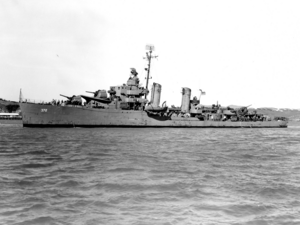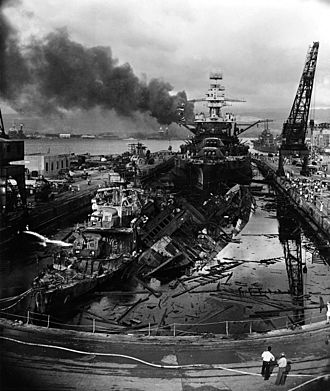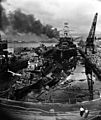USS Cassin (DD-372) facts for kids
 |
|
Quick facts for kids History |
|
|---|---|
| Name | Cassin |
| Namesake | Stephen Cassin |
| Builder | Philadelphia Navy Yard |
| Rebuilder: | Mare Island Naval Shipyard |
| Laid down | 1 October 1934 |
| Launched | 28 October 1935 |
| Commissioned | 21 August 1936 |
| Decommissioned | 7 December 1941 |
| Recommissioned | 15 November 1943 |
| Decommissioned | 17 December 1945 |
| Fate | Sold for scrap, 25 November 1947 |
| General characteristics | |
| Class and type | Mahan-class destroyer |
| Displacement | 1,500 long tons (1,500 t) |
| Length | 341 ft 4 in (104.04 m) |
| Beam | 35 ft (11 m) |
| Draft | 9 ft 10 in (3.00 m) |
| Speed | 37 knots (69 km/h; 43 mph) |
| Complement | 158 officers and crew |
| Armament |
|
The USS Cassin (DD-372) was a type of warship called a destroyer in the United States Navy. She served before and during World War II. The ship was named after Stephen Cassin, who was an officer in the U.S. Navy.
The Cassin was built at the Philadelphia Naval Shipyard. She was launched on October 28, 1935. Mrs. Helen Cassin Carusi Lombard, a great-granddaughter of Stephen Cassin, helped launch the ship. The Cassin officially joined the Navy on August 21, 1936.
Contents
Life of the USS Cassin
The Cassin spent some time being changed and improved until March 1937. After that, she sailed to the Caribbean and Brazil.
In August 1937, while in dry dock at the Philadelphia Naval Shipyard, an accident happened with a steam pipe. This caused injuries and sadly, some deaths.
In April 1938, the Cassin joined the main fleet at Pearl Harbor. She took part in yearly training exercises in the Hawaiian Islands and the Panama Canal Zone. During 1939, she worked along the West Coast of the United States. She helped with torpedo and gunnery training. By April 1940, she was sent to the Hawaiian Detachment. The Cassin went on patrols and training missions in the Pacific Ocean. From February to April 1941, she sailed to places like Samoa, Australia, and Fiji. In the fall of 1941, she visited ports on the West Coast.
The Attack on Pearl Harbor
On December 7, 1941, the Cassin was in dry dock at Pearl Harbor. She was next to another destroyer, the Downes, and the battleship Pennsylvania. During the surprise attack by Japan, a bomb hit the Downes. This caused her fuel tanks to break open.
The fuel caught fire, and the flames spread to both the Downes and the Cassin. The Cassin slipped from her blocks and leaned against the Downes. Both ships were badly damaged by the fires. The Navy thought they were completely lost. The Cassin was officially taken out of service on that same day.
Rebuilding and Return to Service
Even though the ships were badly damaged, their engines and other parts were saved. These parts were sent to the Mare Island Naval Shipyard. There, entirely new ships were built using the salvaged equipment. These new ships kept the names and hull numbers of the old ones.
The Cassin was put back into service on February 5, 1944. She arrived back at Pearl Harbor on April 22. Her first job was to escort other ships from Majuro until August.
Helping in the Pacific War
The Cassin helped in the war by attacking enemy caves and bombarding the island of Aguiguan. This helped American forces take control of Tinian from August 15 to 25. After that, she escorted ships from Saipan.
On October 9, she helped bombard Marcus Island. Then, on October 16, the Cassin joined a larger group of ships. This group sailed northeast of Luzon during the landings on Leyte. After the landings, her group was sent to get more fuel and supplies at Ulithi.
However, when American forces found a Japanese fleet heading for the Battle of Leyte Gulf, the Cassin's group was called back. On the afternoon of October 25, her group launched planes. These planes attacked the Japanese ships in one of the longest-range air strikes of the war.
Final Missions and End of War
The Cassin then helped prepare for the attack on Iwo Jima. She bombarded the island on the nights of November 11–12, 1944, and again on January 24, 1945. She also patrolled, escorted ships, and performed radar picket duties around Saipan.
On February 23, she sailed from Saipan to escort an ammunition ship to the newly invaded Iwo Jima. She returned to Guam on February 28 with a hospital ship. In mid-March, she went back to Iwo Jima for radar picket and air-sea rescue duties. She continued these duties for most of the rest of the war, with breaks at Guam and Saipan for supplies and repairs.
The Cassin went through a typhoon on June 6, 1945. During the storm, one of her crew members was lost overboard. On July 20, she bombarded Kita-Iwō-jima. On August 7, she stopped and searched a Japanese hospital ship. She made sure it was following international rules. Since there were no problems, she let the ship go.
After the war ended, the Cassin continued air-sea rescue missions off Iwo Jima. She helped guard the air evacuation of prisoners of war who were released from Japan.
What Happened to the Cassin?
The Cassin returned to Norfolk, Virginia, on November 1, 1945. She was officially taken out of service there on December 17, 1945. The Cassin was sold for scrap metal on November 25, 1947.
The flag that was flying on the ship during the attack on Pearl Harbor is now on display at the Jerry Falwell Library at Liberty University. The ship's bell is kept at the Office of Naval Intelligence in Suitland, Maryland.
Awards and Recognition
The Cassin earned six battle stars for her service during World War II.
Images for kids




